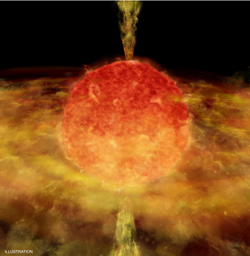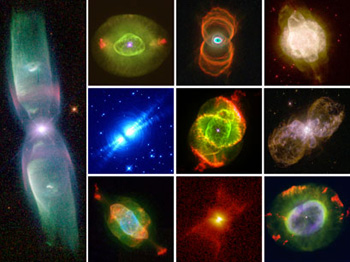What happens when a star with a planetary system (or perhaps a close stellar companion) gets old, expands into a red giant, and engulfs its neighborhood?
This:
“This”, in this case, is the star BP Piscium (or just BP Psc), a star a bit less than twice the mass of the Sun located about 1000 light years away. The picture is actually a composite of both an optical image from the Lick Observatory (in white and green) and X-rays using the orbiting Chandra Observatory (purple).
The jets of matter streaming away are usually seen around young stars. When a star forms, there is a thick disk of material surrounding it. Due to processes not fully understood yet (though we know it has to do with the disk, the star’s spin, and the star’s magnetic field), matter and energy can be focused into those two beams, and they can blast away from the star’s poles at high velocity, stretching for several light years.
But there’s a monkey in the wrench here: BP Psc isn’t a young star. We know this for several reasons. One is that it’s nowhere near a star-forming region, and young stars with beams like that are never found outside of stellar nurseries. Second, spectra indicate it’s a red giant, a star like the Sun at the end of its life. And third, while it is emitting some X-rays, as young stars do, it’s not nearly bright enough or emitting them in the way young stars do. In fact, the X-ray spectrum matches that of an old star that is spinning rapidly.
All in all, it really looks like BP Psc is an old star masquerading as a young one. How is it doing that?
The key is in those beams. We think you need a disk surrounding the star to help focus them. How does an old star get a disk? Ah, well, when a star like the Sun gets old and becomes a red giant, it expands. A lot. The Sun can go from a diameter of a little over a million kilometers to a monster size of a hundred million kilometers or more! When the Sun does this (in about 6 billion years or so), it’ll swallow Mercury and Venus. We’re not sure the Sun can get big enough to consume the Earth, but we do know some stars get that big.
 When a star expands, its rotation slows too. The usual example is of a figure skater who can increase their rate of spin by drawing in their hands – you’ve seen it many times, no doubt. The opposite is true as well: if you spin rapidly, you can open up your arms to slow down. Stars do the same thing: a star like the Sun that takes once per month to spin now might take years to rotate once around when it becomes a red giant.
When a star expands, its rotation slows too. The usual example is of a figure skater who can increase their rate of spin by drawing in their hands – you’ve seen it many times, no doubt. The opposite is true as well: if you spin rapidly, you can open up your arms to slow down. Stars do the same thing: a star like the Sun that takes once per month to spin now might take years to rotate once around when it becomes a red giant.
Now imagine a big planet like Jupiter (or a very small red dwarf star) orbiting close in to a star like that. It may orbit the star in a matter of days or weeks, and remember the star itself rotates far more slowly than that. When it expands and swallows up that planet, the planet won’t just vaporize; it can take years for it to totally be destroyed. And during that time it’s orbiting inside the star! A star is just gas, and when it becomes a red giant it gets big and its density drops even more. As bizarre as it sounds, something much denser like a planet can orbit inside a red giant for some time.
So the planet is inside the star, mixing it up like a whisk in a bowl of batter. This can cause all sorts of havoc, including making the star to expel material along its equator to form a disk. A lot of that matter might be from the companion itself, broken up in the chaotic process.
What we’re left with is a weird star: it’s old and big and used to have a companion (or several), but now is spinning rapidly, wearing a thick disk around its middle, and blasting out those beams of material.
In other words, BP Piscium!
Interestingly, there’s some thinking that this disk might be thick enough to actually form planets once again. We can’t be sure about that with this example, but we’re getting very good at finding planets around stars. It would be amazing if, one day, we found what look like very young planets orbiting a very old star. If that were the case then we might have more evidence of what’s going on inside of BP Psc.
 I’ll also note that we have lots more evidence of similar events: some stars blow off shells of material when they die. These inaptly-named planetary nebulae (called that because in a small telescope they can look like the disks of planets) come in all manners of bizarre shapes, including some indicating their parent stars were spinning rapidly. Since a solo red giant spins slowly, it’s been thought for years that these nebulae indicate the stars are swallowing either a binary star companion or perhaps inner giant planets. In fact, my old research advisor Noam Soker postulated this to explain planetary nebulae long before the first super-Jupiter planetary companion was ever found.
I’ll also note that we have lots more evidence of similar events: some stars blow off shells of material when they die. These inaptly-named planetary nebulae (called that because in a small telescope they can look like the disks of planets) come in all manners of bizarre shapes, including some indicating their parent stars were spinning rapidly. Since a solo red giant spins slowly, it’s been thought for years that these nebulae indicate the stars are swallowing either a binary star companion or perhaps inner giant planets. In fact, my old research advisor Noam Soker postulated this to explain planetary nebulae long before the first super-Jupiter planetary companion was ever found.
One of the things I love about science is how everything fits together. Since we’re describing reality, things have to fit together! So when we find an object like BP Psc, one that causes us to scratch our heads, we can turn to other observations, other knowledge, and try to figure out what’s going on. That’s why science is far more than just a compendium of knowledge; it’s a tapestry, a complex weave, where everything relies on everything else. And just like an exceptional tapestry, it’s a thing of beauty and wonder.
Image credits: BP PSC: X-ray (NASA/CXC/RIT/J.Kastner et al), Optical (UCO/Lick/STScI/M.Perrin et al); Illustration: NASA/CXC/M.Weiss; Planetary nebulae: NASA/HST/Bruce Balick